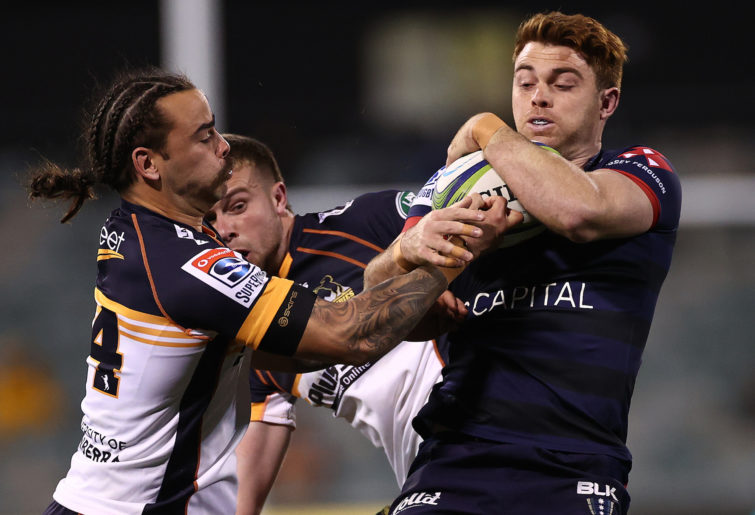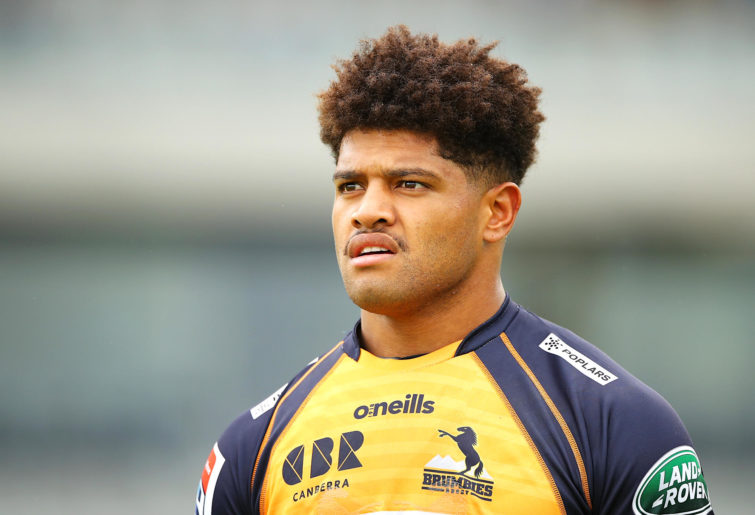We’ve only had four games played with the new law variations in place, and the Brumbies and Western Force have only played one game each over the first two rounds.
I can’t stress the ‘early’ part of ‘early observations’ enough.
But we’ve seen all of the variations used to some degree already, save for the replacement of a player issued with a red card. And while it’s a little hard to know when that one may be first used, we have seen enough of the other Super Rugby AU tweaks to start talking about them.
Breakdown and offside focus
There has only been a slight decrease in the number of penalties per game across the two rounds, though it’s worth noting the plus-or-minus 25 penalties per game is a long way below the numbers from the first few rounds of Super Rugby Aotearoa. And obviously, not all 25 per game are necessarily for breakdown or offside line infringements.
But the point in mentioning all this is that the Australian teams – even with the benefit of three weeks’ worth of game vision from over the ditch and intra-squad games overseen by the local referees involved – haven’t actually made any massive adjustments yet.
And if the 22 to 27 penalties we’ve seen across the four AU games is an acceptable level in the eyes of officialdom, then it may well be the case that no further adjustments are needed. Coaches will always want their teams to concede fewer penalties while simultaneously looking for every advantage they can, but it’s not like the referees have acted on yellow card threats for repeated breakdown and offside penalties.
Four yellow cards in four games is not too different to the rate of issue we saw in seven rounds of ‘normal’ Super Rugby this year.
It does, however, ‘feel’ like the offside line is still something they’re getting used to, even for the Reds, Rebels and Waratahs who have now played 160 minutes under the renewed focus. Force skipper Ian Prior made mention on Saturday night that this was the one area they needed to work on specifically.
Certainly though, we have seen breakdown accuracy being rewarded, with players realising more and more that there are benefits to be had in being first onto the ball. Those getting themselves into position early enough to have a crack at lifting the ball have been rightly rewarded, and if anything, this has highlighted that the defensive clean-out has been off the mark.

(Photo by Cameron Spencer/Getty Images)
Goal-line dropouts
It’s already clear that defensive sides are doing their best to pull the pick-and-drive ball-carrier over the line, which then gives them a quick restart via the dropout, and which teams are invariably kicking as long as they possibly can, thus turning their goal-line defence into immediate field position advantage.
This isn’t a bad thing at all, and it brings with it two immediate benefits: the game is back underway far quicker than via even the cleanest five-metre scrum, and it enforces attacking teams to be accurate in both their body-positioning and the timing of their shove for the try line.
We saw this during the NRC last season and it had exactly the same impact. It definitely improves goal-line defence, and it ensures teams pick their moments a lot better on the pick and drive, rather than just endless phase building for the sake of tiring tacklers out.
A little bit of confusion remains around no longer being able to ground the ball in-goal, with more than a few players visibly trying to work out whether they can force the ball and walk back to the 22, or whether they need to run. Kick-chases are waking up to this though, which means that kicks previously given up on remain in play longer.
Kick variations
We’ve not seen many kicks within the attacking 22 force a contest in lieu of the mark being called as yet, mainly because teams have quickly worked out that twenty-two metres actually isn’t a lot of room to play with. Even with a ruck only a metre or two out, a kicker needs to be set pretty deep in order to give themselves the time needed to put a contestable kick into the corner.
And with a ruck only a metre or two out, the defenders won’t really be that far behind the ball when it reaches the kicker. I’ll watch on with interest around this, but already I do wonder if it’s an idea that sounded good in theory, but maybe doesn’t work out that way in practice.
There’s no doubt teams are seeing the benefits of the 50-22 kick, however. Reece Hodge pulled out a crucial lineout throw-winning kick for the Rebels in extra time on Friday night, and the Waratahs second-half turnaround on Saturday night was massively boosted by two superb kicks from Karmichael Hunt, notwithstanding that one of them was later deemed to have been awarded in error.

Jack Maddocks of the Waratahs catches a kick (Photo by Mark Kolbe/Getty Images)
Teams are definitely looking for them, and back-field defences are playing noticeably deeper already as a result. This isn’t a bad thing and can only help improve the positioning of Australian fullbacks and back three players.
The flow-on is that the extra space that is being created can be like fool’s gold, in that it’s not necessarily as big as it may appear, especially if the drifting winger’s positioning is spot on.
So while there’s more space being created in the front line and just behind it, I think back field players are starting to recognise more opportunities for counterattack with the ball charging forward.
Interestingly though, I think 22-50 kick opportunities are being missed.
My issues with this reverse allowance remain, but while ever they’re in play we might as well try and make the most of them. And I reckon there were two or three occasions during the Rebels-Reds game when both sides were so pre-occupied with returning kicks with even longer kicks that space behind the defensive line in the opposition half was being missed, and thus, the chance to launch a set piece attack was lost with it.
Extra time not necessarily Super
Well, you’ve got to try something to see how it goes, and what the first use of Super Time on Friday night told us is that in wet conditions, it’s actually pretty difficult to manufacture field position and the points-scoring opportunities that come with it.
Neither the Rebels or Reds could tuck the ball under the arm and build phases for fear of turnover, so kicking for territory become the only real option.
But this also meant that much of the fifteen or so minutes played of the five minutes each way was in the twenty metres either side of halfway. In this almost no-man’s land, it was too far out for drop goal attempts, and back field players would still be able to call for the mark on attacking kicks into the 22.

Rob Valetini. (Photo by Mark Kolbe/Getty Images)
So what we saw was two teams trying not to concede penalties and a referee determined not to blow one.
Interestingly, both the Rebels and Reds backed the concept for breaking fulltime deadlocks post-match, and I’m going to hold judgement until I’ve seen Super Time used in dry conditions.
It makes no sense to scrap it after one use, but it was interesting to see that being called for in all the reaction.
Equally, I’m really not sure what changes could be made to it. You either play extra time or you don’t.































































































